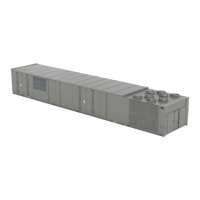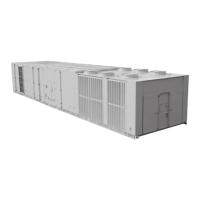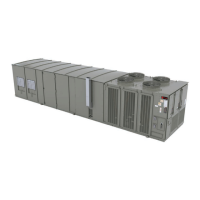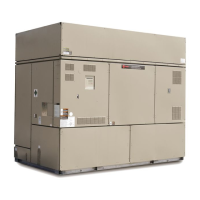RT-SVX073A-EN
159
Charging by Subcooling
The outdoor ambient temperature must be between 65 and
105°F and the relative humidity of the air entering the
evaporator must be above 40 percent. When the
temperatures are outside of these ranges, measuring the
operating pressures can be meaningless. Make sure hot
gas bypass (if applicable) is not flowing when taking
performance measurements. With the unit operating at
“Full Circuit Capacity”, acceptable subcooling ranges for
air-cooled units is between 10°F to 23°F.
Measuring Subcooling
1. At the liquid line service port, measure the liquid line
pressure. Using an R–410A pressure/temperature
chart, convert the pressure reading into the
corresponding saturated temperature.
2. Measure the actual liquid line temperature as close to
the liquid line service port as possible. To ensure an
accurate reading, clean the line thoroughly where the
temperature sensor will be attached. After securing the
sensor to the line, insulate the sensor and line to isolate
it from the ambient air. Use a thermocouple type probe
for an accurate reading.
Note: Glass thermometers do not have sufficient
contact area to give an accurate reading.
3. Determine the system subcooling by subtracting the
actual liquid line temperature (measured in step 2) from
the saturated liquid temperature (converted in step 1).
Standard Ambient Units
The following Table gives the minimum starting
temperatures for Standard Ambient Units. Do not start the
unit in the cooling mode if the ambient temperature is
below the recommended operating temperatures.
Table 61. Minimum ambient
Minimum Starting Ambient
Unit Size Standard Ambient
90-150 45
Note: Minimum starting ambients in degrees F and is based on unit
operating at min. step of unloading, and unloading and 5 mph wind
across condenser
Electric, Steam and Hot Water
Start-Up
1. Ensure that the “System” selection switch at the remote
panel is in the Off position.
2. Close the disconnect switch or circuit protector switch
that provides the supply power to the unit terminal block
or the unit-mounted disconnect switch.
WARNING
Hazardous Voltage!
Failure to disconnect power before servicing could
result in death or serious injury.
Disconnect all electric power, including remote
disconnects before servicing. Follow proper lockout/
tagout procedures to ensure the power can not be
inadvertently energized. Verify that no power is
present with a voltmeter.
Important: Do not open the service access doors while
the unit is operating. HIGH VOLTAGE IS
PRESENT AT TERMINAL BLOCK OR
UNIT DISCONNECT SWITCH.
3. Turn the 115 volt control circuit switch and the 24 volt
control circuit switch to the On position.
4. Open the User Interface access door, located in the
unit control panel, and press the Manual Overrides key
to display the first service screen. Refer to the latest
edition of the appropriate programming manual for VAV
applications for the Manual Overrides screens and
programming instructions.
5. Use tables in “Voltage Imbalance,” p. 93 to program the
following system components for operation by scrolling
through the User Interface displays:
Electric Heat
Supply Fan (On)
Variable Frequency Drive (100% Output, if applicable)
RTM Occ/Unocc Output (Unoccupied)
Heat Stages 1 & 2 (On)
Steam or Hot Water Heat
Supply Fan (On)
Variable Frequency Drive (100% Output, if applicable)
RTM Occ/Unocc Output (Unoccupied)
Hydronic Heat Actuator (100% Open)
Open the main steam or hot water valve supplying the
rooftop heater coils.
6. Once the configuration for the appropriate heating
system is complete, press the Auto key.
WARNING
Rotating Components!
Failure to disconnect power before servicing could
result in rotating components cutting and slashing
technician which could result in death or serious
injury.
During installation, testing, servicing and
troubleshooting of this product it may be necessary
to work with live and exposed rotating components.
Have a qualified or licensed service individual who
has been properly trained in handling exposed
rotating components, perform these tasks.
7. Press the TEST START key to start the test.
Unit Startup

